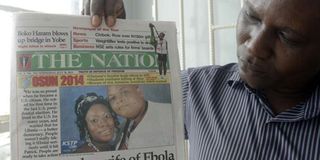Against tremendous odds, Nigeria beat Ebola; Kenya has taken note of its success

A man holds a newspaper featuring a front page story on the death of Liberian diplomat Patrick Sawyer (pictured with his wife Decontee) who died of the Ebloa virus in Lagos on July 30, 2014. PHOTO | PIUS UTOMI EKPEI |
What you need to know:
- Strategy: For a country that has long been accused of severe corruption, Nigeria has beaten back Ebola in record time. How did they do it?
- Lagos, with a population of 21 million, was poised for unprecedented disaster but, three short months later, has been declared Ebola-free by the World Health Organisation.
When Liberian diplomat Patrick Sawyer landed in Lagos, Nigeria, on July 20, he was visibly ill, having come from burying his sister who had died of Ebola in Liberia.
He collapsed at the airport and was taken to hospital, where he insisted that he only had malaria.
Three days of malaria treatment had no effect and the admitting doctor and the hospital director detained Mr Sawyer, in spite of threats from Liberian authorities, to run Ebola tests.
He was confirmed to have Ebola and died shortly thereafter. The attending doctor, Dr Stella Adadevoh, too contracted Ebola and died.
Lagos, with a population of 21 million, was poised for unprecedented disaster but, three short months later, has been declared Ebola-free by the World Health Organisation.
Here are some things that helped Nigeria contain Ebola so efficiently.
Early identification: The index patient/patient zero the first patient in a population to be identified with a disease outbreak was Sawyer and he was identified and quarantined early.
Kenya is equipped to quickly identify its own patient zero through enhanced surveillance across all 34 ports of entry (both land and airports).
Eleven Infra red thermo scanners will be installed in three international airports and major land ports — Namanga, Busia and Malaba to improve surveillance.
Good governance: The government of Nigeria responded quickly, allocating generous amounts of money to deal with the situation.
A presidential decree was issued, enabling officials to access mobile phone records and use law enforcement agencies where necessary to track down people at risk.
Even the hospital that received Sawyer was well governed. This helped to confine the spread of the disease.
Similarly, the Government of Kenya has released funds to support the Ebola preparedness and response plan.
Key areas include public awareness, isolation infrastructure, training, coordination, surveillance.
Laboratory facilities: Nigeria has first-rate virology laboratories equipped and staffed to make quick and reliable diagnoses.
Kenya’s Kemri laboratories are recognised as regional centres of diagnostic excellence.
We also have WHO reference laboratories to support countries in the region.
Outstanding detective work: Nigeria did a world class job of contact tracing and isolating the 20 people and their families who had been in touch with Sawyer at First Consultant Hospital.
Through this, the Nigerian government found 898 people that the initial 20 had been in touch with; these 898 were visited EVERY DAY for 21 days to check for the first symptoms of Ebola.
Kenya has trained rapid response teams and other trained in contact tracing.
Excellent awareness campaigns: According to WHO, a previously used polio immunisation campaign was repurposed to encourage the early reporting of Ebola symptoms.
One of the key messages was that early detection and supportive care greatly increased an Ebola patient’s prospects of survival. They sold hope and it worked.
Our ministry’s newspaper and television campaign has informed the citizens of the dangers of Ebola, how it is transmitted, how to avoid it and what to do if one suspects one has contracted it.
A fully functional emergency command centre: When Nigeria was trying to eradicate polio several years ago, the Gates Foundation helped to fund a command centre, fully equipped with GPS tracking equipment to ensure that children were tracked down and given their polio shots.
When Ebola made its appearance in Nigeria, that centre was converted to handle the emergency operations of Ebola.
Hydration: Several of the doctors who got the disease say that drinking at least five litres of water/salt and sugar oral rehydration solution was one of the main reasons for their recovery.
“I had to mentally tell myself, ‘You have got to drink this fluid, whether it tastes nice or not,’” Survivor Dr. Adaora Igonoh told the Associated Press.
A little luck: It was lucky that none of the other people on the flight got infected even though Mr Sawyer apparently vomited before, during and after the trip.
Nigeria was also lucky that there were 10 experts from the Centre for Disease Control (CDC) in Lagos at the time, and that they had access to the fully-equipped command centre.
Kenya has 150 specialists in infectious diseases control and management. We even sent our team to support capacity building in Liberia in July.
Mr Macharia is the Cabinet Secretary, Ministry of Health





